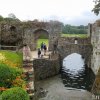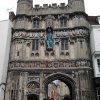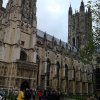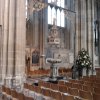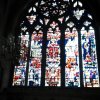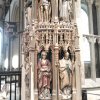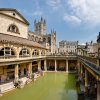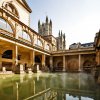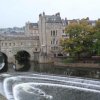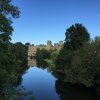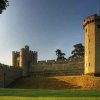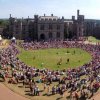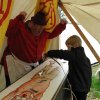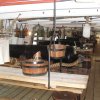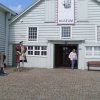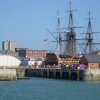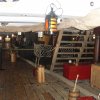Leeds Castle
The Loveliest Castle in the World
Rising majestically from the still waters of its moat, surrounded by 500 acres of parkland and gardens, Leeds Castle is without a doubt one of the most beautiful venues in Kent. Coined 'The Loveliest Castle in the World', it is the perfect place for a great day out with the family or a romantic getaway with a loved one!
Leeds Castle has always been a palace to entertain and impress, with every generation leaving its mark. Today's interiors are the result of the massive refurbishment by top European designers throughout the 1920s and 30s for its last private owner, Lady Baillie.
Each year brings a new daily programme of activities and events. Whether you're passionate about porcelain, eager to discover the parkland wildlife or are just looking for old fashioned fun, check our website daily to see what's on.
On rainy days, we bring activities indoors – meet our owls, or enjoy storytelling in the warm restaurant over a mug of hot chocolate. The guides in the castle will be delighted to take time to show you our treasures, and there's lots in the education centre for younger visitors. If it's raining, children come in free! (Please check the website before you come for details.)
Key to the Castle tickets to Leeds Castle are valid for one year, so you can visit the castle and grounds as many times as you like. (Day tickets are also available; please see our website for more information).
Canterbury Cathedral
Canterbury Cathedral is one of the oldest Christian churches in England and it continues to play a central role in English Christianity. Originally founded in 602 AD by St. Augustine, it still functions as the cathedral of the Archbishop of Canterbury, the leader of the worldwide Anglican Communion.
Canterbury was an important spiritual center ever since Augustine, but it became a major pilgrimage destination after the martyrdom of St. Thomas Becket in 1170 (familiar to most as the subject of Geoffrey Chaucer's humorous Canterbury Tales).
The grandeur of the architecture reflects Canterbury's historic and religious importance, as does the magnificent collection of medieval stained glass windows depicting miracles experienced at Thomas' shrine, biblical scenes, prophets and saints.
What to See at Canterbury Cathedral
The exterior of Canterbury Cathedral immediately impresses by its size, but also rewards closer attention to its details. Viewed directly from the south, the abrupt change from Romanesque to Gothic is clearly evident - to the right (east) are round arches, blind arcades, and rough surfaces; to the left are the abundant pointed arches and pinnacles of the Gothic nave.
Decorating the Romanesque exterior are intertwined blind arches embellished with decoratively carved columns and figurative capitals, all of which date from Archbishop Anselm's reconstruction around 1120. Many of the capitals are weathered beyond recognition, but others still clearly display proud Green Men and other interesting medieval characters.
The main entrance is through the Gothic southwest porch, built in 1424-25 by Thomas Mapilton and 1455-59 by Richard Beke. It was restored with new statues of Canterbury's most notable archbishops by Theodore Pfyffers in 1862. There are some details to spot here, too - look for grinning faces and tiny symbols carved along the top.
The nave terminates at a great Gothic choir screen (a.k.a. pulpitum) at the top of a wide stairway. The pulpitum was built about 1455 by Richard Beke and originally had sculptures of Christ and the twelve apostles along with the shield-bearing angels and six kings that survive today.
East of the choir is the large Trinity Chapel, a level higher than the rest of the interior and surrounded by an ambulatory. It is reached by stone stairs on either side, which have been worn down from the feet (and sometimes knees) of centuries of pilgrims.
The Trinity Chapel was built specifically for the Shrine of St. Thomas, which stood here from 1220 to 1538, when it was destroyed on orders of King Henry VIII. It has been left empty and a single candle burns over the site of the shrine.
The floor of the Trinity Chapel, near the west end, has a set of interesting inlaid marble roundels representing the signs of the zodiac, months of the year, virtues and vices. These were added in the early 13th century to embellish the shrine. They are badly worn today, but many can still be identified.
The ambulatory around the Trinity Chapel is home to some of the most interesting and accomplished stained glass in Canterbury Cathedral. Most of the glass is original, ranging in date from about 1180 to 1220, but there were significant restorations (and replacements) made in the 19th century.
Circling around the ambulatory are a total of eight windows depicting the Miracles of St. Thomas Becket. The first window, in the north ambulatory, depicts some of the events leading to his martyrdom, but the rest tell stories of ordinary people who experienced miracles by praying to the saint or visiting his shrine.
The narratives depicted in these windows provide a fascinating glimpse into medieval life, particularly its most common illnesses and accidents. Many scenes take place around Thomas' tomb, which is shown in its original position in the crypt. It was only after the Trinity Chapel and its windows were completed that his relics were moved to the new shrine.
The far east end of the cathedral is occupied by an apse chapel known as the Corona ("crown"), because it once housed the relic of St. Thomas' head. Here there are two more medieval windows of interest: the Tree of Jesse and the Redemption Window. Both date from about 1200.
From the Tree of Jesse only two original panels survive, which are displayed in the far left window: King Josiah and the Virgin Mary. The entire window has been reconstructed with modern glass to its right. The Redemption Window is a typological window, showing four Old Testament "types" (foreshadowing events) for each of five scenes related to the Passion and Resurrection of Christ. You can explore the Redemption Window in full illustrated detail here.
Two more typological windows, equally fascinating, survive in the north choir aisle. They are earlier than the Becket Windows, dated to about 1180. There were originally six of these windows; the surviving panels have been compiled into what are now called Typological Window 2 and Typological Window 3.
For a good look at most of the medieval stained glass found throughout the cathedral (with even more waiting to be processed), please see our feature article on Canterbury Cathedral's Stained Glass Windows and its accompanying Stained Glass Photo Gallery.
Another notable feature of the ambulatory are its many tombs of archbishops and royals. The most famous of these is the Tomb of the Black Prince (1330-76), topped with a bronze chainmailed effigy of the knight, in the south ambulatory. It's not clear how he got his romantic nickname; his contemporaries knew him as Edward of Woodstock, Prince of Wales. He was the eldest son of a king (Edward III) and the father of a king (Richard II), but was never king himself because he died before his father.
The massive crypt beneath the east end of the cathedral is one of the most fascinating parts of the building (and, alas, was closed when I visited). Built under Archbishop Anselm in the early 1100s, it still has extensive Romanesque murals and exquisitely carved columns and capitals.
Stonehenge
Stonehenge is a massive stone monument located on a chalky plain north of the modern-day city of Salisbury, England. Research shows that the site has continuously evolved over a period of about 10,000 years. The structure that we call "Stonehenge" was built between roughly 5,000 and 4,000 years ago and that forms just one part of a larger, and highly complex, sacred landscape.
The biggest of Stonehenge's stones, known as sarsens, are up to 30 feet (9 meters) tall and weigh 25 tons (22.6 metric tons) on average. It is widely believed that they were brought from Marlborough Downs, a distance of 20 miles (32 kilometers) to the north.
Smaller stones, referred to as "bluestones" (they have a bluish tinge when wet or freshly broken), weigh up to 4 tons and come from several different sites in western Wales, having been transported as far as 140 miles (225 km). It's unknown how people in antiquity moved them that far. Scientists have raised the possibility that during the last ice age glaciers carried these bluestones closer to the Stonehenge area and the monument's makers didn't have to move them all the way from Wales. Water transport through raft is another idea that has been proposed but researchers now question whether this method was viable.
No one knows why ancient people built Stonehenge, but it seems to have been arranged to face the midsummer sunrise and midwinter sunset.
Building Stonehenge
The story of how Stonehenge, and its sacred landscape, was built is evolving rapidly as new archaeological discoveries are made. The IBM Visual and Spatial Technology Centre at the University of Birmingham is using an array of technologies, including ground penetrating radar and magnetometers, to map Stonehenge and its environs. The project has produced an enormous amount of data, which scientists haven't fully analyzed.
In addition other research projects have also made recent finds, such as evidence for widespread prehistoric hunting and what may be a new road. When the new discoveries are combined with older finds, it shows that Stonehenge was just one part of a complex and constantly changing sacred landscape.
From what scientists can tell, Salisbury Plain was considered to be a sacred area long before Stonehenge itself was constructed. As early as 10,500 years ago, three large pine posts, which were totem poles of sorts, were erected at the site.
Hunting played an important role in the area. Recently researchers uncovered roughly 350 animal bones and 12,500 flint tools or fragments, just a mile away from Stonehenge, the finds dating from 7500 B.C. to 4700 B.C. The presence of abundant game may have led people to consider the area sacred.
The researchers have also discovered a massive wooden building, which may have been used for burial rituals. Also, dozens of burial mounds have been discovered near Stonehenge indicating that hundreds, if not thousands, of people were buried there in ancient times. At least 17 shrines, some in the shape of a circle, have also been discovered near Stonehenge.
As time went on the landscape continued to change. Around 5,500 years ago, two earthworks known as Cursus monuments were erected, the longest of which ran for 1.8 miles (3 km).
More construction occurred around 5,000 years ago with postholes indicating that either bluestones or upright timber posts were propped up on the site. Then, around 4,600 years ago, a double circle made using dozens of bluestones was created at the site.
By 4,400 years ago, Stonehenge had changed again, having a series of sarsen stones erected in the shape of a horseshoe, with every pair of these huge stones having a stone lintel connecting them. In turn, a ring of sarsens surrounded this horseshoe, their tops connecting to each other, giving the appearance of a giant interconnected stone circle surrounding the horseshoe.
By 4,300 years ago, Stonehenge had been expanded to include the addition of two bluestone rings, one inside the horseshoe and another between the horseshoe and the outer layer of interconnected sarsen stones.
Construction at Stonehenge slowed down around 4,000 years ago. As time went on the monument fell into neglect and disuse, some of its stones fell over while others were taken away. The archaeologists found an interesting connection between the earlier Cursus monuments and the later Stonehenge. They found that the longest Cursus monument had two pits, one on the east and one on the west. These pits, in turn, align with Stonehenge's heel stone and a processional avenue.
"Suddenly, you've got a link between [the long Cursus pit] and Stonehenge through two massive pits, which appear to be aligned on the sunrise and sunset on the mid-summer solstice," said University of Birmingham archaeologist Vincent Gaffney, who is leading the project to map Stonehenge and its environs.
Why was Stonehenge constructed?
While there have been many theories as to why Stonehenge was constructed, recent discoveries indicate that Stonehenge's landscape was a sacred area, one that underwent constant change.
"It's part of a much more complex landscape with processional and ritual activities that go around it," Gaffney told Live Science, noting that people may have traveled considerable distances to come to Stonehenge.
One new theory about Stonehenge, released in 2012 by members of the Stonehenge Riverside Project, is that Stonehenge marks the "unification of Britain," a point when people across the island worked together and used a similar style of houses, pottery and other items.
It would explain why they were able to bring bluestones all the way from west Wales and how the labor and resources for the construction were marshaled.
In a news release, professor Mike Parker Pearson of the University of Sheffield said that "this was very different to the regionalism of previous centuries. Stonehenge itself was a massive undertaking, requiring the labour of thousands to move stones from as far away as west Wales, shaping them and erecting them. Just the work itself, requiring everyone literally to pull together, would have been an act of unification."
Bath
Visit historic Bath
Superb Roman remains, glorious Georgian architecture, spring water spas, and first-class shopping – the golden city of Bath has it all. The Romans were really onto something when they built this gem of a city, and after just one visit you'll be in love with it too.
Top attractions
The Romans discovered Bath's hot spring waters over 2000 years ago – see just how they enjoyed them at the world-famous Roman Baths .
You can experience the mineral-rich waters for yourself at the Thermae Bath Spa – don't miss the spectacular views of Bath city from the rooftop pool.
It's not all about the Romans though – Jane Austen was Bath's most famous resident, and you can step into her world at the fascinating Jane Austen Centre .
Shopping
Bath's reputation for shopping dates back to Georgian times - Jane Austen mentions the fashionable Milsom Street in her novel Persuasion, and you can still treat yourself to some designer chic right there.
Stall Street, Union Street, and the SouthGate shopping centre are all home to great high street names, while the Upper Town is a treasure trove of irresistible boutiques and vintage clothing.
If you're in the market for a great one-off find, head to the creative melting pot that is the Artisan Quarter, where you'll find a vibrant selection of independent craft and curio shops.
Eating and drinking
Bath is home to a few local delicacies, but there are a couple of crowd-pleasers that rise above the rest. Try the light and airy Sally Lunn Bun at Sally Lunn's Refreshment House, and the sugary Bath Bun at many of the city's tearooms.
Speaking of tea, Bath serves a cracking afternoon tea – treat yourself to the champagne version at the Pump Room. And if that gives you a taste for luxury, head to the Michelin starred Bath Priory Restaurant for dinner.
Arts and culture
Bath's vibrant arts and culture scene offers something for every particular taste.
Traditionalists will love the Victoria Art Gallery, which houses work by leading artists from the 15th century to the present day, and the West End productions at the Theatre Royal.
For something a little different, catch the cutting edge performances at Ustinov Studio, and the contemporary exhibitions and talks at the Institute of Contemporary Interdisciplinary Arts.
Music and nightlife
The Romans were the first to party here, and the party spirit is still going strong in Bath today. Get your night off to a great start with live music or comedy at the Chapel Arts Centre or the award-winning Komedia.
Jazz fans should head to the Green Park Brasserie and Bar, which hosts 4 evenings of live jazz every week. And if you've packed your dancing shoes, nightclubs OPA, Second Bridge, and Circo are great venues for dancing the night away.
For families
There's plenty for little ones to see and do in and around Bath. The Egg at the Theatre Royal is an award-winning theatre especially for children, with a year-round programme of shows and events for kids aged from 18 months to teenagers.
If you're in town for the Bath Festival of Children's Literature, your little ones will love meeting their favourite authors, illustrators, storytellers, and poets. And if you have animal lovers in the family, a trip to Longleat Safari Park is a must.
History and heritage
A designated UNESCO World Heritage Site and one of Britain's Heritage Cities, Bath is home to some of the finest architectural sights in Europe, including the stunning Royal Crescent, the Circus and Pulteney Bridge – one of the most beautiful bridges in the world.
Don't miss the beautiful Bath Abbey , where the first King of England was crowned in AD973.
Warwick Castle
Visit a medieval castle and discover 1,000 years of fascinating history, brought to life with spectacular live entertainment.
- See stunning interiors, restored furniture and items from hundreds of years ago with a tour of the grand State Rooms and Hall
- Regular live entertainment includes jousting tournaments and bird of prey displays (summer only)
- See the mighty Trebuchet, the largest working catapult in the world!
- Get amazing views of the surrounding countryside from the castle towers
- Explore 64 acres of beautiful landscaped gardens, have tea in the conservatory and meet the resident peacocks!
Audio guides are available in the following languages:
English, French, Spanish, German, Italian, Japanese, Portuguese and Chinese.
Why buy from us?
- Warwick Castle tickets from us are cheaper than buying on the day
- Flexibility: Tickets from us are open dated and can be used at any time
- Discounted student rates are exclusively available through VisitBritain Shop
- Discounted cream tea offer tickets are also exclusively available from us
Beautiful architecture
The mighty towers of Warwick Castle date back to the 12th Century, and are some of the best examples of medieval architecture in Britain.
Explore the towers including Caesar's Tower, the tallest in the castle, which stands as tall as 10 double decker buses! And visit The Gaol, the castle's original dungeon, to see graffiti left by prisoners hundreds of years ago!
To experience the castle in all its glory, take a free daily tour of the grand interiors, see the beautiful State Rooms, learn the secrets of the Grand Hall and bask in the tranquil atmosphere of the Chapel.
Live entertainment
Meet costumed characters from the castle's past in the Time Tower, see brave knights compete in jousting tournaments in the summer, and see live falconry displays in the castle gardens. May to September only - check the schedule when you arrive for the day.
The Princess Tower
Visit the Princess Tower and step into a fairytale, meet a princess and see a Royal Wedding being planned! Perfect for little princesses, the Princess Tower is included in your ticket – just book a time slot when you arrive at the castle.
Gardens and playground
Surrounding the castle are 64 acres of parkland landscaped by "England's greatest gardener", Capability Brown. Wander along the serene banks of the River Avon, visit the fragrant Victorian rose garden and say hello to the stunning peacocks who are free to roam the castle grounds!
In the summer, you'll find daily jousting tournaments and bird of prey displays in the gardens – check the schedule when you arrive at the castle. And for kids, there is a large playground to explore and conquer – designed as a mini fortress and perfect for little ones to explore.
The world's biggest working catapult!
Don't miss the spectacle of the Mighty Trebuchet, which is shot twice daily from April to October from the heart of the castle gardens. A reconstruction of the original medieval design, the original was used in battle against the castle in the early 13th century!
Portsmouth
Her Majesty's Naval Base, Portsmouth (HMNB Portsmouth) is one of three operating bases in the United Kingdom for the British Royal Navy, (the others being HMNB Clyde and HMNB Devonport). Portsmouth Naval Base is part of the city of Portsmouth; it is located on the eastern shore of Portsmouth Harbour, north of the Solent and the Isle of Wight. Until the early 1970s it was officially known as Portsmouth Royal Dockyard (or HM Dockyard, Portsmouth);[1] the shipbuilding, repair and maintenance element of the base was privatized in the late-1990s/early-2000s.
The base is home to one of the oldest dry docks in the world (the oldest and second-oldest are in Greenock on the River Clyde),[citation needed] as well as being the headquarters for two-thirds of the Royal Navy's surface fleet. The base is also home to a number of commercial shore activities, including shipbuilding and ship repair (operated by BAE Systems Maritime); naval logistics, accommodation and messing; and personnel support functions (e.g. medical and dental; education; pastoral and welfare) provided by Defence Equipment and Support.
The base is the oldest in the Royal Navy and it has been an important part of the Senior Service's history and the defence of the British Isles for centuries. At one time it was the largest industrial site in the world.[2] Around the year 2000, the designation HMS Nelson (which until then had been specific to Portsmouth's Naval Barracks in Queen Street) was extended to cover the entire base.
The "Semaphore Tower" at HMNB Portsmouth in 2007
The harbour is under the control of the Queen's Harbour Master (QHM), currently Commander Nigel Hare, who is the regulatory authority of the Dockyard Port of Portsmouth, an area of approximately 50 square miles (130 km2) that encompasses Portsmouth Harbour and the Eastern Solent. QHM Harbour Control is based in the Semaphore Tower building. Shipping movements are handled by a team of admiralty pilots headed by the Chief Admiralty Pilot, Anthony Bannister.
Portsmouth naval base is home to two-thirds of the Royal Navy's surface ships, and employs up to 17,200 people. In addition, Portsmouth is building part of, and will be the home port of the two new Royal Navy aircraft carriers ordered in 2008, HMS Queen Elizabeth and HMS Prince of Wales; they will require the harbour to be dredged.[3] This project has secured the base's future for the next forty years and will revitalise shipbuilding in the city.[4] However due to budget cuts in 2013 shipbuilding in Portsmouth was closed in favour of BAE keeping open its yards in Glasgow. It has been speculated this was to help retain Scotland in the union and it has been suggested by the BAE chairman that shipbuilding could return to the city if Scotland voted for independence.[5]
The Naval Base is also home to the Portsmouth Historic Dockyard, which allows members of the public to visit important maritime attractions such as Mary Rose, HMS Victory and HMS Warrior.




